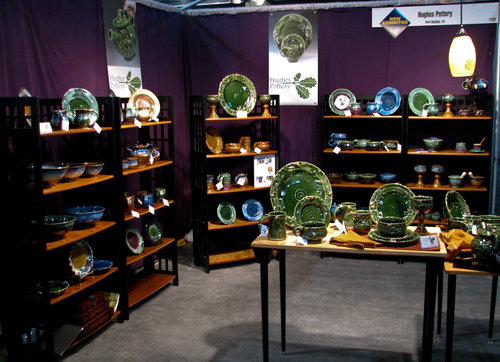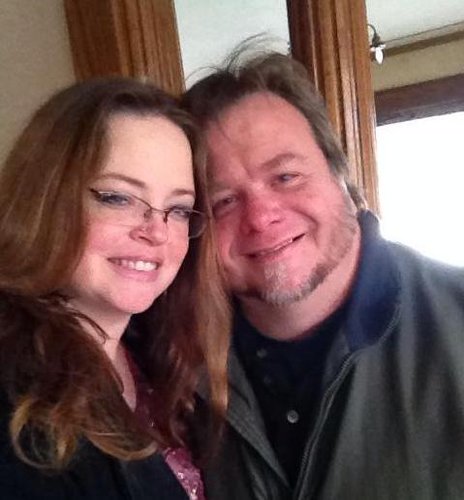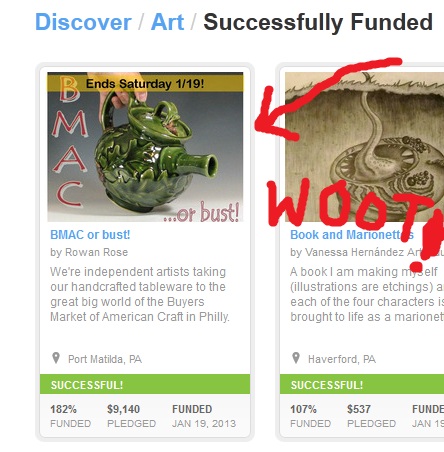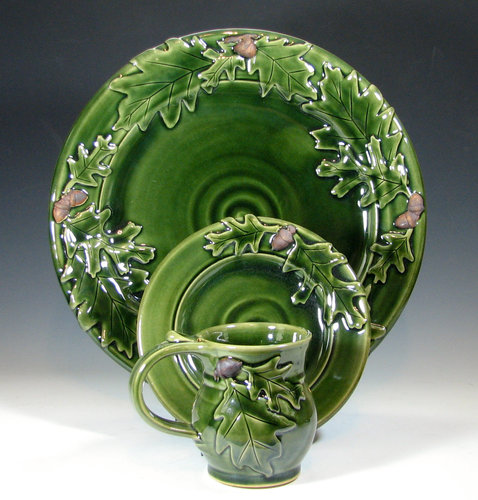by Carolyn Edlund
Rowan Rose and Charles Hughes of Hughes Pottery raised almost twice their crowdfunding goal.

Hughes Pottery started their campaign to raise money for a trade show.
I recently spoke with Rowan on their strategies, and how other artists can do it, too.
AS: You had a plan to do a wholesale trade show, and realized it would be too expensive to go it alone. What made you think of crowdfunding?
RR: I had been a Kickstarter member since 2012, backing a pretty diverse group of projects. When our pottery business started having growing pains, and we needed bigger studio space, I started crafting a campaign to fund those capital improvements. Then our plans changed, and the opportunity to be part of a major wholesale trade show came up, so I took that draft campaign and completely overhauled it to fund our trade show experience.
AS: Why did you choose Kickstarter over other platforms?
RR: To be honest, I didn’t take a very long look at other platforms. What sold me on Kickstarter was that I was already a member and knew my way around a bit and that they had a very nice tutorial on creating and launching a successful campaign. Plus, they were (and still are I think) the largest crowdfunding site on the net. I wanted to toss my hat into the biggest ring out there!
AS: Did you do any research before putting together your Kickstarter campaign?
RR: Oh, yes. I spent weeks looking at other successful campaigns. Since there weren’t many that were ceramic specific, I looked at small, artisan food campaigns instead. I paid attention to the “feel” of each campaign, and how they were selling their idea. Were they earnest or a little silly? Did they give a lot of small details or just pitch the “grand idea” behind the business or product? How much personal information was part of the story? I also looked at what kind of rewards they offered, the images they used, and even the music they picked for their videos!
I can’t emphasize enough the importance of not having to reinvent the wheel when it comes to how to market yourself. I’m not saying you should copy other people’s ideas exactly, but the internet contains a wealth of free marketing information if you’re willing to do the work of digging it up.
I knew what moved me to back other people’s campaigns, and I applied that to our project. As I said before, Kickstarter provides a lot of tutorial information, so that was a great starting point to being crafting the campaign. I also poached a lot of concepts and marketing ideas from other Kickstarter campaigns.

Potters Charles Hughes and Rowan Rose
AS: How would you describe your approach to creating your campaign, and especially the video?
RR: In my mind, the larger campaign was broken down into three smaller bites:
- Who are we, and why should you care?
- What are we trying to do?
- How can you help? (and here’s what you get for helping!)
The first piece is the most important, and the one that I believe people with unsuccessful campaigns don’t spend enough time developing. You need to connect with potential backers, get them to understand your point of view and get them emotionally invested in who you are. These are, in many cases, total strangers who don’t know anything about you or your business. And you have just a few seconds to get them to pause long enough to click on your campaign, and only a few minutes to get them to care enough to read further.
The second part is critical in that you not only have to explain what you are doing, but why anyone should care about it. It’s not enough to say “We want the money to do this big show.” So we framed our story as “Help the small town artists who are shooting for the big time.” It was the perfect way to make our story relatable to potential backers who fantasize about “living the dream” of being artists.
The final piece is asking for the money! It sounds easy, but you have to ask confidently and make it a real call to action. You’ve taken people on a little journey, introducing yourself, and telling your story. Now you have to bring them to the finish line and get them to commit to supporting you financially.
The video and the text pretty much covered the same points, though for the video I had to work hard to distill all the points into just a sentence or two. Having some experience writing radio commercials helped! Since I didn’t have much in the way of video footage, I mostly used a picture slideshow instead.
Recording the audio and linking it with the photos to create the video took the most time of any part of the project. Some people feel it’s not necessary to bother to include a video at all (and Kickstarter no longer requires it), but I’m convinced it made a big difference in how much money we raised.

Hughes Pottery’s successful Kickstarter campaign.
AS: You use humor in your Kickstarter project, and it worked for you. Had you considered another approach?
RR: I did not. Seriously, I am a funny person! I use humor daily, even in business situations, and it seems to put people in a good, relaxed head space. And I’ve seen the marketing value in not taking yourself too seriously. Potential customers are so bored with dry advertising campaigns, I think it’s a real breath of fresh air to have fun instead.
I was a little concerned that people might confuse the good-natured silliness with being less than earnest about the business itself, so I had several people read the draft with that in mind. Everyone gave me a thumbs-up, so I ran with it. It was a bit of a risk, but people loved the humor, and responded playfully in return. In my opinion, that is the beginning of a great relationship.
I even used humor in the backers’ surveys I had to send out to get mailing addresses and other info from folks. They have it set up that if you ask a question in the survey, backers must answer it, or they can’t submit it. So I added things like “What’s your favorite color?” and “What is your favorite dessert?” along with the important information. I don’t know if people appreciated having to answer, but I certainly had fun reading the submissions!
My only regret is that I promised people “drunkenly maudlin” thank you notes and was so stressed fulfilling the actual, tangible pottery rewards that I didn’t have time to create and include them.
AS: What made you choose the incentives you offered for contributors?
RR: You would think that would be the easiest part of the whole thing, but it was quite difficult. The best advice I have is threefold:
- Make your incentives something desirable and worth the price
- Have a good range of dollar amounts represented
- Don’t be afraid to list higher ticket reward levels
It’s so important to come up with rewards that feel…rewarding! I’ve had several acquaintances launch crowdfunding campaigns since ours happened, and most of them failed to meet their goals. Why? Quite frankly – crappy rewards. It doesn’t have to be dollar for dollar (I back you for $35 to get a widget worth $35), but backers should feel they are getting good value for their monetary support. I am not going to support someone’s campaign at the $50 level and get a magnet. Who would buy a $50 magnet? Crowdfunding isn’t charity, so don’t make your potential backers feel like it is.
The biggest revelation was the number of people backing us at higher levels. I mistakenly thought we would end up having a lot of backers at the $5 or $10 level, and fewer at the higher dollar amounts. But, we had more people backing us at $35 level than the $5 and $10 levels combined. And several people backed us at amounts of $300 and over. That was the most surprising thing of all!
The nice thing about Kickstarter is the ability to edit your campaign to add reward levels after it’s launched. So if you find you’re running out of $35 rewards slots, you can generate a new reward at that level. Or add some other cool incentive that people are asking for, which is what we did when backers started asking for a whole place setting of pottery as a reward.
I will tell you something else. There were people I knew I could count on to support us and spread the word; really good friends and close family I figured would be in from day one. I wrote them personal emails letting them know about our project and asking them to spread the word to their social circles. And they didn’t. At all.
Conversely, I was shocked at total strangers and distant acquaintances whom I barely spoke to who threw themselves into our campaign with gusto. They backed with higher dollar amounts than I ever would have expected, and tirelessly flogged our campaign on Facebook to their friends. Moral of the story? Don’t have preconceived ideas about where your money and support will come from!

Some of the pottery used as rewards on the crowdfunding campaign.
AS: How many times did you promote your Kickstarter campaign through social media? Email blasts?
RR: I think we had a little over a thousand folks in our Facebook fan page to start and another 500 on our MailChimp customer list. I sent out one email to our MailChimp list, but I found that garnered little results. So we almost exclusively promoted via Facebook, primarily on the Hughes Pottery page, but also on our personal pages as well. There may have been a tweet or two mixed in!
We posted the campaign on Facebook often, maybe twice a week in the beginning, and with more frequency as we got closer to certain goals to whip up excitement. Once we exceeded our original $5,000 mark (in less than 15 days), it got a little crazy. People were really invested in seeing us roll those thousands over to get to $10,000, and we crafted our promotion to encourage that. We didn’t make it that far, but we did raise a little over $9,000.
I thought we would have a good number of backers that would just find us on Kickstarter naturally, but the vast majority of support was funneled to our campaign via our Facebook promotion.
AS: What was the most satisfying thing that happened in this experience?
RR: The love and support. It sounds all sappy and very un-businesslike, but when you spend so much time creating in a vacuum, it’s pretty overwhelming to have such a large groundswell of praise (and money!) wash over you. I knew our customers liked what we did enough to buy or work, but the Kickstarter campaign provided a lot of validation.
AS: What did you do after your campaign succeeded? Are you following up with the contributors?
RR: It was a bit of a whirlwind. We did the trade show, came back and reorganized, started filling wholesale orders and creating work to fulfill our backer rewards. We used the backer updates through Kickstarter to communicate with our backers for quite a while after the campaign, for almost a year.
AS: Would you do another Kickstarter campaign? If so, what would you do differently?
RR: I think the biggest change I’d make is tweaking the rewards. We needed to be smarter about adding in the cost of postage and packaging when pricing the reward tiers; I think we got caught a little short in the end. I would also have been much more generous in setting the dates they would be shipped.
Everything took much longer than expected, and as a result, everything was late. I used backer updates to let people know the status of their rewards, but I wish I didn’t have to deal with the extra stress.
But we had such a positive experience that we would definitely run another Kickstarter campaign again. In fact, my husband and I have been talking about it for the last few months!
Have you ever run a crowdfunding campaign? Did it work for you? Please share in the comments below.

It’s great to hear another’s experience. I really responded to “really good friends and close family I figured would be in from day one… And they (weren’t). At all.” Ouch. I experienced that as well but was shocked when others (also distant acquaintances) came in unexpectedly as high level donors to fill that void.
Face to face meetings with your lead donors long before the campaign begins may be a more effective way to get their support. It’s definitely gutsy but venture funding works on that premise. I lived far away from those who I figured I could count on and had to resort to phone calls–did not work.
Also, I had to understand that the crowdfunding campaign was 4-6 weeks, and the project took a year; but they’re over now. I still have relationships with those who did not support the effort–they continue to be a part of my life after the campaign and project end. Don’t strain relationships with friends or family over these things–it could easily happen!
Thanks for sharing and congratulations on your successful campaign (and the impact it had on your business)!
I thoroughly enjoyed this article, fascinating concept. Thank you Carolyn, Rowan Rose and Charles.
I know of kickstarter but have never considered it for my art, loved the article tho, it was super interesting and inspiring!! I’m really happy they got well above their goal!!
Thanks everyone!
James, we really didn’t take it all too personally, and it didn’t ruin any relationships for us…but it was an interesting wake up call. Never assume where your support will come from!
We had a fantastic experience running a crowdfunding campaign and it really expanded my marketing and networking knowledge.
I am glad that this worked out for you I am very intrigued with the idea of crowd funding to fund a business. Best of luck on your project and business growth.
Excellent article and advice. As a verteran of 3 successful Kickstarter projects of my own, plus advisor status on 4 others, I would second everything said here. Getiing your known supporters (and as they said, not neccessarily face to face friends and family, but people who follow your work) on board early is crucial.
My 3rd project, I boldly decided to go on a very short funding cycle (19 days) but I contacted my most ardent supporters and asked that they pledge in the first 48 hours, if they could. I funded in under 36 hours and went on to raise 245% of my goal amount, slightly over $10,000.
I also overestimated when rewards could be shipped and as a result could fulfill rewards months early in some cases. When you using a handmade item as a reward, it is crucial to limit amounts available to be delivered in a certain month. This accomplishes 2 things. First, if there are only 25 of a reward to be shipped in March, it creates a need to act immediately, even if you then offer another 25 of the same item to be delived the next month. I like the idea of an early bird special, with each time you offer a new similar reward, the price goes up.
And it cannot be stressed enough, all backers deserve a one on one thank you, at minimum by email. One of my backers (someone I didn’t know at all) said of the many projects he supported, I was the first that sent an email thank you. I’m pretty sure he will remember me and think kindly if I ever run another project.
Doing your advance work, optimizing you launch/ending day and time can mean the difference between popping the champagne cork and crying in your beer. So happy to hear of a successful, well thought out campaign. Congratulations.
Wow! Super info, Anne. I can see why you are an advisor on Kickstarter projects!